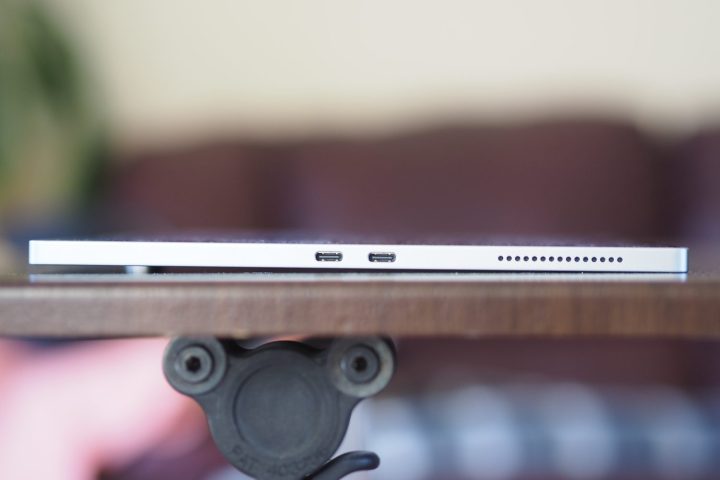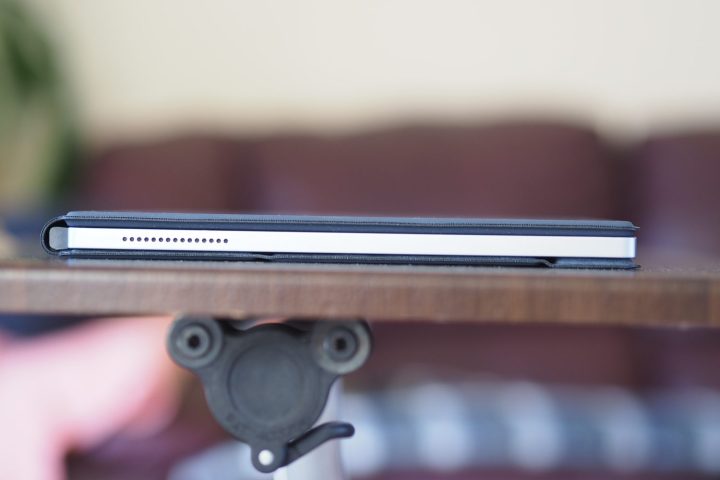Dell XPS 13 2-in-1 (9315)
MSRP $1,150.00
“The Dell XPS 13 2-in-1 provides competent productivity performance with a high-quality IPS display, but its battery life is mediocre and its inking experience can’t live up to the best.”
pros
-
More affordable price
-
Solid build quality
-
Excellent productivity display
-
High resolution webcam
-
Good productivity performance
cons
-
Folio has limited angles
-
Keyboard read flat
-
No integrated kick stand
-
No headphone jack
The detachable Windows tablet is making a comeback. It’s been years since we had some new designs in this category, which has been dominated by Microsoft’s Surface Pro line — but 2022 has seen the debut of some new models that hint at a comeback.
The new Dell XPS 13 2-in-1 (9315) might be the most substantial of the bunch, ditching the convertible form factor for something that aims to take on the Surface Pro 9 directly. The tablet’s late arrival means that Dell should have had plenty of time to optimize its design. So how did it do? Well, it’s a solid design with several welcome features, but it doesn’t do quite enough to stand out against the industry’s most iconic machine.
Specs and configurations
| Dell XPS 13 2-in-1 9315 | |
| Dimension | 11.50 inches x 7.90 inches x 0.29 inches |
| weight | 1.60 pounds Folio 1.23 pounds |
| processor | Intel Core i5-1230U Intel Core i7-1250U |
| Graphics | Intel Iris Xe |
| R.A.M. | 8GB LPDDR4x 16Gb LPDDR4x |
| screen | 13.0-inch 3:2 3K (2,880 x 1,920) IPS touch |
| Storage | 512GB PCIe SSD 1TB PCIe SSD |
| touch | yes |
| ports | 2 x USB-C with Thunderbolt 4 Optional SIM slot |
| Wireless | WiFi 6E and Bluetooth 5.2 |
| cam | 1080p from facing with infrared camera for Windows 11 Hello 2160p rear facing |
| operating system | windows 11 |
| batteries | 49.5 watt-hours |
| Price | $999+ |
Price and configurations
The XPS 13 2-in-1 starts at $999 for a Core i5-1230U CPU, 8GB of RAM, and a 512GB SSD. My review unit came with the Core i5, 16GB of RAM, and a 512GB SSD for $1,150. The most expensive configuration is the $1,500 model with a Core i7-1250U, 16GB of RAM, and a 1TB SSD. It’s $100 to add in Dell’s folio keyboard and active pen.
That’s the same entry-level price as the Surface Pro 9, but Microsoft’s tablet is equipped with just 128GB of storage at the low end. The Surface Pro 9 is a whopping $2,700 with a Core i7, 32GB of RAM, and a 1GB SSD, and matching Dell’s high-end configuration, it’s $2,200. On top of that, the Surface Type Cover keyboard and Surface Slim Pen 2 add another $280 to the price.
A solid but less comfortable design
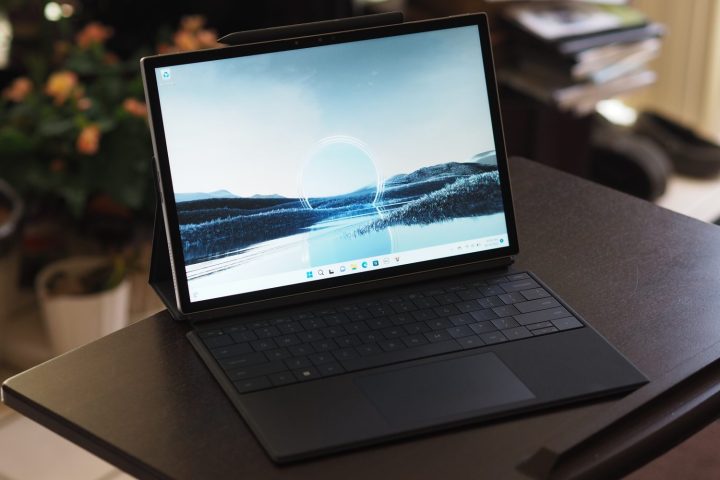 Mark Coppock/Digital Trends
Mark Coppock/Digital Trends
There are few computing products that so distinctly define a type as does the Microsoft Surface Pro 9. The Surface Pro kicked off the modern detachable tablet, and Microsoft has done a solid job of improving it over the years. Simply put, the XPS 13 2-in-1 competes against a strongly established standard.
The Surface Pro 9 isn’t perfect, though, so a new product has a chance to shine. The XPS 13 2-in-1 starts off nicely in that direction, with a slate portion that adheres to the XPS line’s usual solid built quality and tight tolerances. It’s aluminum around the edges with a glass back cover intended to best accommodate the Wi-Fi and optional 5G WWLAN radios. As I hold the tablet, I’m surprised that the back is glass — it feels a lot like metal. The XPS 13 2-in-1 easily matches the excellent Surface Pro 9 in its solidity.
Dell’s tablet is a square design with sharper corners than the rounded-off surface, and it enjoys smaller bezels around all its edges. You can pick between Sky (blue) or Slate (black) colors with the Wi-Fi version and Slate only with the 5G version. The biggest difference in design, and it’s significant, is that the XPS 13 2-in-1 lacks the Surface Pro 9’s integrated and highly flexible kickstand. Instead, you’re limited to the three angles provided by the detachable Dell folio that also houses a keyboard and touchpad and serves as a cover. That makes the XPS 13 2-in-1 less comfortable to use both as a tablet alone and with the folio attached.
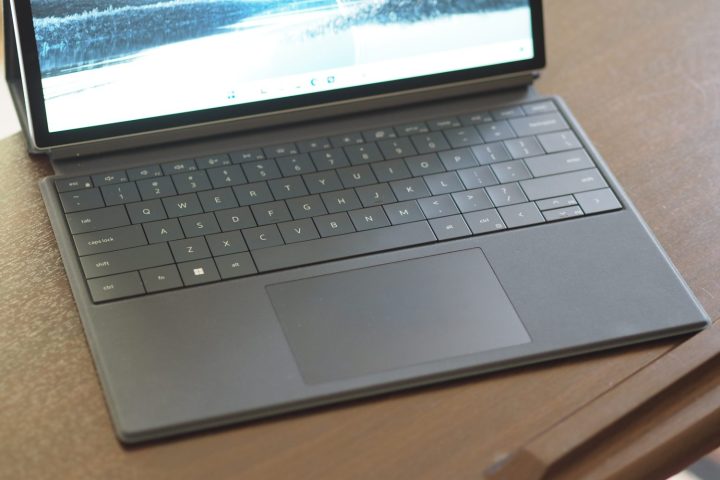 Mark Coppock/Digital Trends
Mark Coppock/Digital Trends
Another difference is with the folio itself. While the Surface Type Cover keyboard props up at an angle for more comfortable typing, Dell’s version only lies flat. The keyboard itself is fine, sporting an edge-to-edge keyboard with large keycaps that’s like the keyboard on the XPS 13 Plus, but it’s not as comfortable to use. The Surface Type Cover has a little bounce that the XPS 13 2-in-1’s keyboard avoids, but without an angle, my wrists got tired more quickly with the Dell. The touchpad integrated into the folio is excellent and offers quieter, more solid button clicks than Microsoft’s version.
The XPS 13 2-in-1 is thinner than the Surface Pro 9 at 0.29 inches compared to 0.37 inches (5G version), and it’s lighter at 1.60 pounds versus 1.95 pounds. That makes Dell’s tablet meaningfully smaller, but both are considerably thicker and heavier with their keyboards attached.
Thanks to its thin chassis, the XPS 13 2-in-1 has just two USB-C ports with Thunderbolt 4, one of which is used for power. Like with the XPS 13 laptops, Dell dropped the 3.5mm audio jack from the tablet and instead offers a dongle in the box (along with a USB-C to USB-A adapter). Microsoft dropped the jack as well. The XPS 13 2-in-1 offers optional 5G WWAN support, only available on the Surface Pro 9 ARM-based 5G version, in addition to Wi-Fi 6E and Bluetooth 5.2.
Its get up and go got up and went
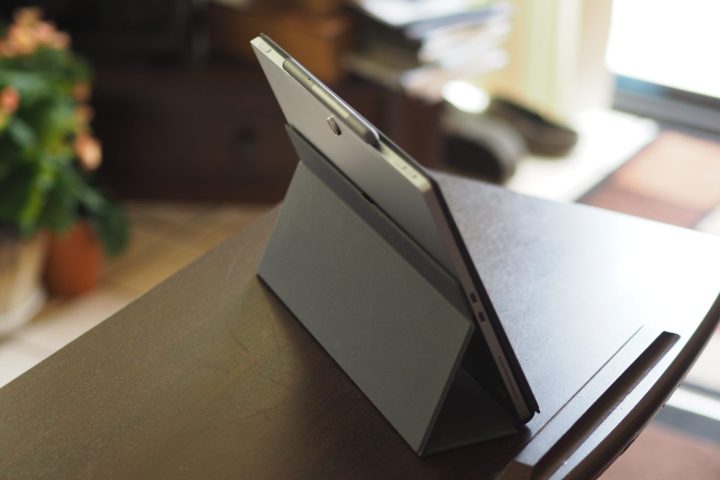 Mark Coppock/Digital Trends
Mark Coppock/Digital Trends
Outside of the Asus ROG Flow Z13, detachable tablets aren’t known for their performance. Even those running Intel CPUs rather than slower (and cooler, longer-lasting) ARM processors aren’t made for speed. The XPS 13 2-in-1 is a classic example, running Intel 9-watt 12th-gen CPUs. You can choose between the Core i5-1230U with 10 cores (two Performance and eight Efficient) and 12 threads and the Core i7-1250U with the same core count but running at 4.7GHz versus 4.4 GHz.
The Surface Pro 9 Intel version offers a choice between 15-watt Core i5-1235U and Core i7-1255U processors (our review unit) with the same core counts and frequencies. We reviewed the XPS 13 2-in-1 with the Core i5, and its performance was mixed against the Surface Pro 9. I tested in both balanced and performance modes using the Dell utility, and it held its own in our Handbrake test that encodes a 420MB video as H.265 while falling behind in Geekbench 5 and Cinebench R23. The latter score was particularly notable, being a benchmark that pushes the CPU for more extended periods.
The XPS 13 2-in-1 is fanless and so completely silent. That limits its thermal performance, and it ran at low frequencies throughout our testing but didn’t officially throttle. The chassis was a little warm during extended high-CPU use, but it was never too hot to handle. Interestingly, the XPS 13 2-in-1 was faster than the Dell XPS 13 9315 with the same CPU in all but Cinebench.
In the end, the XPS 13 2-in-1 is almost enough for productivity workflows and will match the Surface Pro 9 in typical day-to-day tasks. But it won’t be of much use in creative tasks such as video editing or for truly demanding productivity workers. And it’s not a gaming laptop with its slow implementation of Intel’s Iris Xe graphics.
| Geekbench (single / multiple) |
handbrake (seconds) |
Cinebench R23 (single / multiple) |
PCMark 10 Complete |
|
| Dell XPS 13 2-in-1 9315 (Core i5-1230U) |
Bal: 1.435 / 6.099 Perf: 1.572 / 7.028 |
Ball: 139 Perf: 144 |
Bal: 1.064 / 3.032 Perf: 1.065 / 3009 |
4,535 |
| Surface Pro 9 (Core i7-1255U) |
Ball: 1170 / 6518 Perf: 1.598 / 8.165 |
Ball: 166 Perf: 127 |
Ball: 1124 / 7537 Perf: N/A |
4,045 |
| Dell XPS 13 9315 (Core i5-1230U) |
Bal: 1393 / 4,459 Perf: 1.477 / 5.350 |
Ball: 333 Perf: 192 |
Bal: 1379 / 3457 Perf: N/A |
4,023 |
| HP Specter x360 13.5 (Core i7-1255U) |
Bal: 1.566 / 7.314 Perf: 1.593 / 7921 |
Ball: 169 Perf: 120 |
Bal: 1.623 / 5.823 Perf: 1.691 / 7.832 |
5.203 |
| Asus ROG Flow Z13 (Core i9-12900H) |
Bal: 1.784 / 9.387 Perf: N/A |
Ball: 103 Perf: 87 |
Bal: 1.548 / 9.664 Perf: 1.906 / 13.400 |
6,417 |
Despite its slightly larger battery (49.5 watt-hours versus 47.7 watt-hours) and lower-wattage CPU, the XPS 13 2-in-1 fell behind the Surface Pro 9 in battery life. It hit just six hours in our web browsing test, for example, compared to the Surface Pro 9’s eight hours. The Dell managed 8.5 hours in our local video looping test, which is below average across all the laptops we’ve tested but OK for a tablet.
 Mark Coppock/Digital Trends
Mark Coppock/Digital Trends
The XPS 13 2-in-1 is unlikely to get you through a full day’s work. The charger is small, though, so carrying it around isn’t too much of a burden.
Nice display quality, not as good for inking
 Mark Coppock/Digital Trends
Mark Coppock/Digital Trends
The XPS 13 2-in-1 has a slightly smaller screen than the Surface Pro 9, at 13.0 inches versus 13.3 inches, and its resolution is the same at 2880 x 1920. That makes Dell’s display slightly sharper. The XPS 13 2-in-1’s IPS panel was brighter at 480 nits versus 409 nits, and it had much deeper contrast at 1,840:1 compared to 1,050:1. The colors were about as wide and just average for premium laptops, while accuracy was excellent at a DeltaE of 0.81 (less than 1.0 is suitable for professional work).
In terms of quality, then, the XPS 13 2-in-1’s display is better for productivity users and just as middling for creators who demand the widest color gamut. But its refresh rate is a pedestrian 60Hz, compared to the Surface Pro 9’s fluid 120Hz. And while Dell’s active pen is good and conveniently attaches magnetically to the top for charging, it doesn’t have the haptic feedback built into Microsoft’s Surface Slim Pen 2. Combined with the faster refresh rate, this feature makes the Surface Pro 9 a superior inking experience.
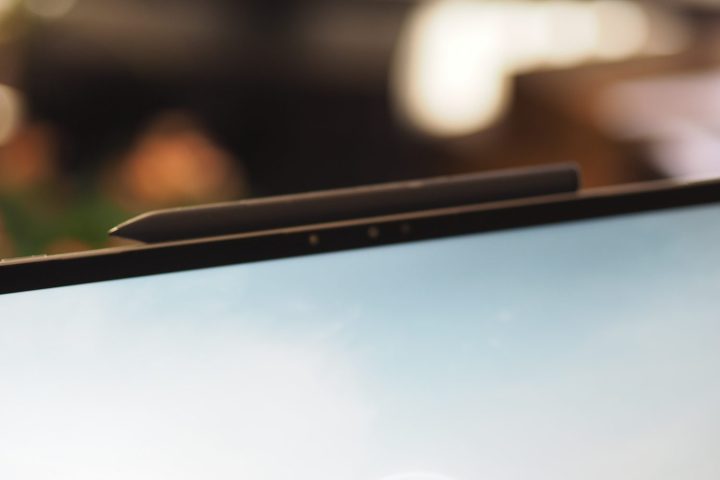 Mark Coppock/Digital Trends
Mark Coppock/Digital Trends
In terms of other multimedia aspects, the XPS 13 2-in-1 has an excellent 1080p front-facing camera and a 2160p rear-facing camera. There’s also an infrared camera for Windows 11 Hello passwordless login, like the Surface Pro 9, while the XPS 13 2-in-1 also includes a fingerprint reader. Two side-firing speakers provide serviceable audio.
Back to the drawing board
The Surface Pro 9 isn’t the perfect Windows tablet. Frankly, such an animal doesn’t exist. But the Surface Pro 9 ends up being a better overall device than the XPS 13 2-in-1. The latter is a fine detachable 2-in-1, but it doesn’t provide any reason other than the price to choose it over Microsoft’s tablet. The XPS 13 2-in-1 isn’t as comfortable to use in tablet mode or with the keyboard attached, and it’s slower with less battery life. If you’re buying a tablet primarily for inking, then the Surface Pro 9 is a better experience there as well.
Then again, price does matter. At the same $1,000 price, you get four times the storage with the XPS 13 2-in-1 than the Surface Pro 9, and when configured with 16GB of RAM and a 1TB SSD, the Dell is $700 less. That’s hard to ignore. But in the final analysis, the XPS 13 2-in-1 isn’t inexpensive enough to make up for its weaknesses, and the Surface Pro 9’s being so expensive doesn’t hand Dell’s tablet a recommendation.
Editors’ Recommendations

